Nissan Maxima
| Nissan Maxima | |
|---|---|
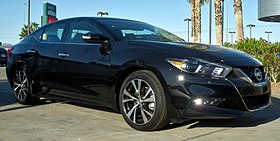 | |
| Overview | |
| Manufacturer | Nissan |
| Also called | Datsun Maxima (1981–1983) |
| Production | 1981–present |
| Body and chassis | |
| Class | Compact car (1981–1988) Mid-size car (1988–present) |
| Chronology | |
| Predecessor | Datsun 810 |
The Nissan Maxima is a mid-size car manufactured by Nissan and sold primarily in North America, the Middle East, and China. Making its sales debut in 1981 for the 1982 model year as the Datsun Maxima, it replaced the earlier Datsun 810. The name "Maxima" dates back to 1980 for the 1981 model year when the upscale 810 sold as the "810 Maxima" in North America. Like the 810, early versions of the Maxima had their origins in the Datsun/Nissan Bluebird. The Datsun brand was phased out in favor of Nissan in 1984 for the 1985 model year, thus becoming the Nissan Maxima.
Most Maximas were built in Oppama, Japan, until the current North American Maximas started being assembled in Smyrna, Tennessee beginning with the 2004 model year.
In some markets beyond North America, the "Maxima" name has also been applied to the Nissan Cefiro and Teana (see below).
Contents
- 1 North America
- 1.1 First generation (G910; 1980–1984)
- 1.2 Second generation (PU11; 1984–1988)
- 1.3 Third generation (J30; 1988–1994)
- 1.4 Fourth generation (A32; 1994–1999)
- 1.5 Fifth generation (A33B; 2000–2003)
- 1.6 Sixth generation (A34; 2004–2008)
- 1.7 Seventh generation (A35; 2008–2014)
- 1.8 Eighth generation (A36; 2015–present)
- 2 Other markets
- 3 References
- 4 External links
North America[edit]
First generation (G910; 1980–1984)[edit]
| First generation (G910) | |
|---|---|
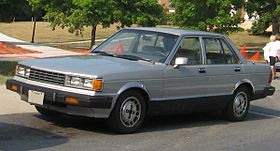 1984 Nissan Maxima | |
| Overview | |
| Also called | Datsun 810 Datsun Maxima |
| Production | 1980–1981 (Datsun 810) 1981–1983 (Datsun Maxima) 1983–1984 (Nissan Maxima) |
| Assembly | Japan: Oppama Plant, Yokosuka, Kanagawa |
| Body and chassis | |
| Body style |
|
| Layout | Front-engine, rear-wheel-drive |
| Related | Datsun Bluebird (910) |
| Powertrain | |
| Engine | |
| Transmission | |
The first car to wear the Maxima name, the second generation Datsun 810, was introduced in 1980 for the 1981 model year. It was essentially a Japanese-market Datsun Bluebird (910) with a 3.9 in (99 mm) longer nose to accommodate the inline-six engine. This model replaced the Datsun 810 (first generation). The second generation Datsun 810 was not sold in Japan, only in North America as the more basic Datsun 810 Deluxe and the fully equipped 810 Maxima.[1] Both were available with either sedan or wagon bodywork.[2] In 1981 for the 1982 model year, all 810s were rebranded as Datsun Maxima. In 1983 for model year 1984, the last year of the first generation Maxima, North American Datsuns began carrying the "Nissan" badge as well. Only 1984 model year Nissans have "Nissan" and "Datsun" badges on the back of the car, although earlier models had a "Datsun" badge with a tiny "by Nissan" section underneath.
For the first model year, the 810 Deluxe was the only version to receive the five-speed manual, while the luxurious 810 Maxima only came with a three-speed automatic.[1] The Maxima's introduction to North America followed the successful introduction of the Nissan S30, and used the same engine and transmission while offering luxurious accommodations and four doors. The sedans have independent rear suspension while the wagon has a leaf sprung live rear axle. The wagon also received rear drums rather than disc brakes.[3]
The second generation retained the same 2.4-liter base engine as the previous Datsun 810, although up 2 to 120 hp (1 to 89 kW) and with more torque available at a lower engine speed.[4] It was also available with the 2.8-liter LD28 OHC inline-six diesel engine (available in the US from mid-1981 through 1983) with either a five-speed manual or a four-speed automatic transmission with overdrive.
Some of the power steering pumps were sourced from General Motors' Saginaw Gear division, while others were sourced from Atsugi. This was the second Nissan to use US-sourced parts besides the Borg-Warner T-5 transmission used in the 82–86 Nissan ZX Turbos. The use of USA-made parts was phased in prior to the passage of local content laws imposed by the U.S. Government.
One unique feature of the car was its phonograph-based voice warning system. Warnings like those for a door being open, etc. would be relayed through the mini phonograph and played for the driver to hear. A common thing to hear would be, "door is open, key is in ignition." 1981 models were the first 'talking car' sold in the US and offered only one voice warning, a female voice reminding the driver to "please turn off the lights".
Second generation (PU11; 1984–1988)[edit]
| Second generation (PU11) | |
|---|---|
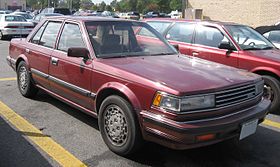 | |
| Overview | |
| Production | July 1984 – August 1988 |
| Assembly | Japan: Oppama Plant, Yokosuka, Kanagawa |
| Body and chassis | |
| Body style | 4-door sedan 4-door hardtop sedan (Japan) 5-door station wagon |
| Layout | Front-engine, front-wheel-drive |
| Related | Nissan Bluebird (U11) |
| Powertrain | |
| Engine | 2.0 L VG20E/VG20ET V6 (Japan) 3.0 L VG30E V6 |
| Transmission | 5-speed RS5F50A manual 4-speed RL4F02A automatic |
| Dimensions | |
| Wheelbase | 2,550 mm (100 in) |
| Length | Wagon: 184.8 in (4,694 mm) Sedan: 181.5 in (4,610 mm) |
| Width | 66.5 in (1,689 mm) |
| Height | Sedan: 54.7 in (1,389 mm) Wagon: 55.7 in (1,415 mm) |
On October 17, 1984[5], the first front-wheel drive Maxima (based on the Bluebird U11) was introduced for the 1985 model year. This Maxima was available with a 157 hp (117 kW), 3.0-liter VG30E V6 engine and a four-speed automatic or a five-speed manual transmission. In Japan, a smaller 2.0-liter version of this engine was fitted. These engines were the first V6 engine to be mass-produced in Japan. The second generation was assigned compact status in the US market. This was the last generation to be available as a station wagon, a version which had been offered since the Datsun 810 days.
In late 1986, the 1987 Maxima was introduced with a freshened exterior and interior. Automatic shoulder belts were now found on both the 1987 sedan and wagons built after February 1987. Luxury amenities were offered on both the "base" GL, later renamed GXE and SE trim levels. Such features for the GL/GXE included digital touch entry system on the driver and passenger side door panel, power windows, locks, antenna, power seats, remote trunk release, voice warning system, optional leather seating, optional heated front seats, an optional Electronics Pkg (a sedan exclusive, it included a digital instruments and a trip computer) and an optional power sunroof (sunroof was standard on Maxima wagons). 15-inch alloy wheels were standard for the Maxima.
An exclusive option for 1988 was the Sonar Suspension System -which was part of the Electronics Pkg- replacing the trip computer that was previously offered. This feature used sonar waves to monitor the road conditions ahead and adjusted the shocks accordingly for the most controlled ride. 1988 was also the year that the previously standard digital touch system offered on the GXE sedan became part of the 'Electronics Package' option as well. The SE (and some GXEs) offered dual power seats, a five-speed manual transmission, three-way shock adjust suspension, front and rear windshield defroster, and a factory-installed security system. The SE also has a small rear spoiler, all-wheel disc brakes, black side rear view mirrors, and body molding (GXE got body-color side rear-view mirrors and matching body molding). Again, the Maxima's prime competitor was the similarly specified Toyota Cressida, which remained rear wheel drive. The Maxima provided a combination of luxury and sporty features while the Cressida was generally seen as being softer and more luxurious.
The Japanese market "Bluebird Maxima" received either four-door hardtop sedan or pillared sedan bodywork and a 2.0-liter V6 engine (with an available turbocharger). It received the smaller V6 engine so that it would comply with Japanese Government dimension regulations that tax larger vehicles. The station wagon bodywork was not available in the home market, with the hardtop exclusive to Nissan Bluebird Store Japanese dealerships.
Third generation (J30; 1988–1994)[edit]
| Third generation (J30) | |
|---|---|
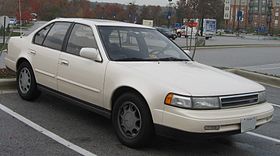 | |
| Overview | |
| Production | August 1988 – March 1994 |
| Assembly | Japan: Oppama Plant, Yokosuka, Kanagawa |
| Body and chassis | |
| Body style | 4-door sedan |
| Layout | Front-engine, front-wheel-drive |
| Powertrain | |
| Engine | 3.0 L VG30E V6 3.0 L VE30DE V6 |
| Transmission | 5-speed manual (88–91 RS5F50A) (SE 91–94 RS5F50V) 4-speed automatic (88–94 RE4F02A) (SE 91–94 RE4F04V) |
| Dimensions | |
| Wheelbase | 104.3 in (2,649 mm) |
| Length | 187.6 in (4,765 mm) |
| Width | 69.3 in (1,760 mm) |
| Height | 1988–91: 55.1 in (1,400 mm) 1991–94: 53 in (1,346 mm) |
The Maxima was redesigned on October 24, 1988[6] for the 1989 model year as the J30 series (not to be confused with the unrelated Infiniti J30) model. Larger dimensions made it the second Japanese sedan sold in North America to qualify as a "mid-size" (after the Mazda 929). Nissan marketed this generation Maxima in North America a four-door sports car and even gave it a "4DSC" window decal showing this, and this generation was briefly sold in Japan, replacing the Nissan Leopard sedan at Nissan Bluebird Store locations. A refresh occurred in August 1991 for the 1992 model year (from July 1991 production), adding a driver's side SRS airbag and the facelifted version was no longer offered in Japan.
It now featured the 160 hp (119 kW), 3.0-liter VG30E V6, with the 190 hp (142 kW), VE30DE unit standard on the SE model starting in 1991. In the United States, the VG30E engine, which featured a variable intake manifold on automatic and manual transmission models, was used on all 1989 to 1994 GXE models and 1989 to 1991 SE models. This generation Maxima was fitted with an independent rear suspension, and continued to offer the road scanning, electronic Super Sonic Suspension (sonar). An interesting feature was the digital touch entry system on the GXE (in conjunction with the new Luxury Package), which allowed the windows to be lowered and the moon roof opened from outside the vehicle on a keypad integrated on the front door handle without the key in the ignition.
The VE30DE engine was exclusively offered on the 1992–1994 Maxima SE. It was a 3.0-liter, 24 valve, DOHC motor. Its iron block was topped with aluminum cylinder heads and featured a dual length intake manifold (5-speed model only), variable intake valve timing, coil on plug ignition, plus a limited-slip differential. The VE30DE was rated at 190 hp (142 kW) at 5600 rpm and 190 lb⋅ft (258 N⋅m) at 4000 rpm, and had a 6500 rpm redline. The SE models can be further distinguished from the GXE by their white-faced gauges, twisted-spoke turbine wheels (.5 inch wider than GXE wheels and similar in design to wheels offered on the Z31 300ZX), body-colored grille, twin-tip mufflers, factory-tinted tail lights, black trim replacing chrome, firmer sport suspension, and optional 5-speed manual transmission. The automatic transmission on all GXEs (RE4F02A) was an innovative compact unit from Jatco, which featured "sport" and "comfort" modes that shifted at different points. The 1992 to 1994 SE received an optional automatic transmission (RE4F04V) that had stronger internals, but kept the "sport" and "comfort" modes. The SE also had a rear spoiler and black side mirrors, whereas the GXE has body-color side mirrors.
During this year, the Maxima was first introduced to the European market, replacing the Laurel. For European markets, the model range was: 3.0, 3.0 S, and 3.0 SE.
Nissan Australia began importing the J30 series for a May 1990 release to replace the locally assembled Nissan Skyline (R31) sedan and station wagon.[7] Powertrain comprised the 3.0-liter VG30E V6 rated at 122 kW (164 hp) and a four-speed automatic. Nissan made the Maxima available in two equipment grades, the M and Ti.[8] The M featured air conditioning, alloy wheels, central locking, cruise control, power steering, and power windows. The Ti added a rear spoiler, climate control air conditioning, anti-lock brakes, electric seats and a PIN touch-pad locking system. The M-based LE of late 1991 featured a CD player and sunroof.[8] There was also a leather/sunroof pack optional on Ti.[7] Nissan Australia released a facelift in January 1993 that included a new grille insert, revised tail lamps, wheels and cabin trim.[9] A driver airbag was now fitted to the Ti, and made optional on the new Executive trim that replaced M.[7] The J30 in Australia was replaced in February 1995 by a new Maxima based on the Nissan Cefiro (A32).[7]
The three variants assembled locally in New Zealand had automatic transmissions and the VG30E Engine only. Versions sold in Japan and Europe had a manual transmission option as an alternative to the automatic transmission that was standard in North America and Australia/New Zealand. The Maxima SE was on Car and Driver magazine's Ten Best list for 1990.
Another Bluebird Maxima continued on as a Nissan Bluebird (U12) and solely as a station wagon with the VG20ET engine during this period until the introduction of the U13 Bluebird , and the Avenir replaced the Bluebird wagon altogether.
Fourth generation (A32; 1994–1999)[edit]
| Fourth generation (A32) | |
|---|---|
 | |
| Overview | |
| Also called |
|
| Production | February 1994 – 31 March 1999 |
| Assembly | Japan: Oppama Plant, Yokosuka, Kanagawa South Africa: Rosslyn, Gauteng |
| Body and chassis | |
| Body style | 4-door sedan |
| Layout | Front-engine, front-wheel-drive |
| Powertrain | |
| Engine | |
| Transmission | 5-speed manual 4-speed automatic |
| Dimensions | |
| Wheelbase | 106.3 in (2,700 mm) |
| Length | 1996–99: 189.4 in (4,811 mm) 1994–96: 187.7 in (4,768 mm) |
| Width | 69.7 in (1,770 mm) |
| Height | 55.7 in (1,415 mm) |
| Curb weight | 2,870 lb (1,300 kg) |
Designed from early 1990[10] to March 1991[11]., the fourth generation Maxima arrived in May 1994 for the 1995 model year as the A32. A new VQ30DE 190 hp (141 kW), 205 lb⋅ft (278 N⋅m) 3.0 liter V6 was the only engine option for the North American market. The VQ30DE earned a first spot on the Ward's 10 Best Engines List, and the VQ has now been recognized consecutively for every year since its introduction (as of 2012, 18 years running).[12] The independent rear suspension of the previous generation was replaced with a lighter and cheaper torsion bar solid axle system, part of a general trend of cost cutting by Japanese manufacturers in the wake of the bursting of Japan's economic bubble of the late 1980s.
The Maxima's primary competitor, the Toyota Cressida, was discontinued after the 1992 model year, with Toyota touting the front-wheel-drive Toyota Avalon, a stretched version of the Toyota Camry introduced in 1994, as its replacement.
In October 1996, the Maxima's exterior was refreshed for 1997, with new five-spoke alloy wheels, plastic (clear-lens) headlights vs. the previous glass headlights, a slightly different front and rear fascia with new redesigned tail-lights, the rear-facing part of the trunk was smoothed out to match the tail-lights, re-designed fog-lights and badge designs, and a chrome grille insert for GLE's (body color for SE models) was added. Among interior changes were a different steering wheel and CD player. Front seat-mounted side impact airbags were added as an option for 1998 and 1999 SE and GLE models. There were also structural modifications to improve crash worthiness for the 1997 to 1999 models. The 1999 Nissan Maxima also saw some minor changes: an Anti-Theft Engine Immobilizer was standard using a chip in the ignition key, as well as some minor body trims.[13]
The 1999 Maxima SE was also available with a Limited Package which consisted of Titanium tinted SE-Limited emblems on the front doors, titanium tinted trunk emblems, and titanium tinted 16" alloy wheels. The interior gauge cluster was also titanium tinted and the optional leather seats were perforated and embossed with SE on the backrests. The front floor mats were also embossed with SE-Limited logos.
The North American 1995 Maxima included a Bose Sound System on the GLE (optional on the SE) which had a 6 speaker sound system, a Clarion system was also an option (non-Bose). The fourth generation Maxima was highly praised for its quiet, roomy interior.
This Maxima was Motor Trend's Import Car of the Year for 1995. The Maxima SE again made Car and Driver magazine's Ten Best list for 1995 and 1996.
The 1995's VQ30DE (3.0 litre) engine produced 190 hp (142 kW) and 205 lb⋅ft (278 N⋅m) of torque. With the manual transmission 0–60 mph took 6.6 seconds with a quarter-mile time of 15.2-seconds at 92.4-mph, making it both the quickest and fastest (142 mph top speed) Japanese sedan on the North American market at that time.[citation needed] A top-of-the-line 1994 Maxima GLE equipped with a four-speed automatic transmission turned in an 8.0-second 0-60-mph run with a 16.0-second/89.4-mph quarter-mile time.[14]
At the time, the Maxima was one of few four-door, six-cylinder cars sold in North America with a standard manual transmission. A viscous limited slip differential came standard on Canadian SE models equipped with the 5-speed manual (in the US, the VLSD was restricted to the Infiniti I30). The automatic was a no cost option, which most Maximas were equipped with.
As the Maxima badge was retired in Japan, this particular generation was sold there as the Nissan Cefiro A32. The Cefiro badge had previously been used on a Nissan Laurel-based, higher specification model with rear-wheel drive (see A31 Cefiro). For the Japanese market, a Cefiro-badged station wagon was also available. One version of the Cefiro (Brougham VIP spec) was sold in the US as the Infiniti I30, yet the Cefiro had subtle differences including different fog light arrangements, one-piece headlights and a few assorted engine options (VQ20/25/30DE). The Cefiro was actually introduced first, in August 1994, and was originally available with 2 and 2.5-liter V6 engines with 155 or 190 PS (114 or 140 kW) JIS.[15]
This generation was also sold as the Maxima QX in Europe and other parts of the world, and was mostly identical to the Japanese Cefiro except for minor trim differences. In Europe a smaller, two-litre V6 engine with 140 PS (103 kW) was available in addition to the larger 3.0, to suit local taxation structures.[15]
Fifth generation (A33B; 2000–2003)[edit]
| Fifth generation (A33B) | |
|---|---|
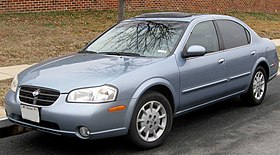 | |
| Overview | |
| Also called | Nissan Cefiro (A33B) Nissan Maxima QX (Europe) |
| Production | April 1999 – December 2002 |
| Assembly | Japan: Oppama Plant, Yokosuka, Kanagawa |
| Designer | Jerry Hirshberg (1997) |
| Body and chassis | |
| Body style | 4-door sedan |
| Layout | Front-engine, front-wheel-drive |
| Related | Infiniti I30/I35 |
| Powertrain | |
| Engine | |
| Transmission |
|
| Dimensions | |
| Wheelbase | 108.3 in (2,751 mm) |
| Length | 1999–2001: 190.5 in (4,839 mm) 2001–03: 191.5 in (4,864 mm) |
| Width | 70.3 in (1,786 mm) |
| Height | 1999–2001: 56.5 in (1,435 mm) 2001–03 GXE: 56.3 in (1,430 mm) 2001–03 SE: 56.7 in (1,440 mm) 2001–03 GLE: 57.1 in (1,450 mm) |
| Curb weight | 3,245 lb (1,472 kg) |
Introduced in May 1999, the 2000 model year Maxima (designated A33B) was a refresh of the previous car, designed at Nissan's La Jolla, California design studio during 1996–1997 under Jerry Hirshberg. The engine was a 222 hp (166 kW) (227 hp SE) 3.0 L VQ30DE V6. The vehicle has a 0–60 mph time of 7.0 seconds. This variant of the VQ30DE was referred to as the VQ30DE-K. In this variation, there were three models (GXE, GLE, and SE). The "GXE" was the base Maxima. The GLE was the "luxury" variant and had 16 inch alloy wheels. All SE models came with a rear trunklid spoiler.[16]
This generation was used for the Infiniti I30 (a rebadged Nissan Cefiro). The 2001 Maxima had a special edition of the SE model which commemorated the 20th anniversary of the Maxima. In addition to the usual SE content, this car had the Infiniti I30's engine, special skirts (ground effects) all around the lower perimeter, and special touches to the interior. It also came with drilled metal "brushed metallic" pedals, a brushed metallic shifter, and stainless steel door sill plates with the name "MAXIMA" stamped into them. The optional leather interior was perforated, unlike that in the regular SE. Finally, the "SE Comfort and Convenience Package" included a sunroof and 17" dark chrome alloy wheels.
This generation of the Maxima saw Nissan introduce a Bridgestone-made engine mount with sensors that communicate with the ECM. Many transmission-like problems such as 'unable to shift into higher gears' resulted from worn engine mounts triggering signals to prevent the vehicle from gaining higher speeds. This problem was not often detected by the diagnostics conducted on the transmission and ECM as they were not the cause of the problem.
In the 2002 model year, the engine was replaced for the whole lineup with a 3.5 L VQ35DE that produced 255 hp (190 kW) and 246 lb⋅ft (334 N⋅m) of torque. In addition, the model got a slight refresh with a larger, revised grille and front bumper openings, revised foglamps with vertical lines in the glass lense, larger Nissan emblem on the grille, a revised headlamp design with high-intensity discharge (HID) low beams, a six-speed manual transmission with optional helical Torsen limited-slip differential borrowed from the Japan market Nissan Skyline GT-R (identified by brushed, metal pedals for the accelerator, brake, and clutch), revised 17-inch 6-spoke alloy wheels in silver on the SE model, new 17-inch 7-spoke machined alloy wheels on the GLE model, clear Altezza-style taillights, a revised rocker moulding/side skirt standard on all models, and interior and refinements over the 2000 to 2001 models. Some interior differences include slightly redesigned seats, a smaller screw-on shift knob on automatic models along with a different shift pattern, a redesigned steering wheel, revised headunits, and a different cup holder lid. 2002-03 SE models equipped with the six-speed manual transmissions were capable of 0-60 acceleration of 6.0 seconds with a 1/4 mile time of 14.7 seconds at 97 mph. The 2002-2003 models posted better braking numbers, requiring 182 feet to stop from 70 mph, compared with the 195 feet of the 2000 model.
For 2003, there was a special SE package called the "Titanium Edition" which came with glossy titanium colour 6-spoke alloy wheels and titanium interior accents. In the United States, a Meridian Edition package was offered which included heated seats and steering wheel (usually leather, although some were available with heated cloth), and a GPS navigation system. The GPS navigation system was never offered in Canada. The Titanium Edition was available in all colours, but a new colour was available only with the Titanium Edition (Polished Titanium). In Canada, all 2002-2003 models came with heated seats and a heated leather wrapped steering wheel. In Russia and Europe, the Maxima was being sold as Nissan Maxima QX.
Sixth generation (A34; 2004–2008)[edit]
| Sixth generation (A34) | |
|---|---|
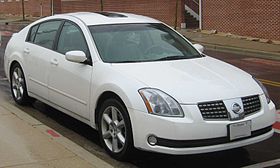 | |
| Overview | |
| Production | January 2003 – May 2008[17] |
| Assembly | United States: Smyrna, Tennessee |
| Designer | Jerry Hirshberg (2000)[18] |
| Body and chassis | |
| Body style | 4-door sedan |
| Layout | Front-engine, front-wheel-drive |
| Platform | Nissan FF-L platform |
| Powertrain | |
| Engine | 3.5 L VQ35DE V6 |
| Transmission | 6-speed manual 4/5-speed automatic CVT |
| Dimensions | |
| Wheelbase | 111.2 in (2,824 mm) |
| Length | 2003–2006: 193.5 in (4,915 mm) 2006–2008: 194.4 in (4,938 mm) |
| Width | 71.7 in (1,821 mm) |
| Height | 58.3 in (1,481 mm) |
| Curb weight | 3,579 lb (1,623 kg) |
The sixth generation Maxima, code-named A34, was only sold in the United States, Canada and Mexico. It was developed from 1998 to 2002, with a March 2001 design freeze.[19] It was introduced in production form as a 2004 model at the 2003 North American International Auto Show. In the US, it came with the venerable VQ35DE, a DOHC V6 engine that produced 265 hp (198 kW) at 5,800 rpm, and 255 lb⋅ft (346 N⋅m) of torque at 4,400 rpm and a standard SkyView fixed glass paneled roof that ran down the center of the roof (from front to back) or an optional traditional style moonroof. Sixth generation Maximas were available in two trim levels, SE and SL. The sporty SE model came standard with 18 inch alloy wheels, P245/45R18 V-rated tires, stiffer suspension, rear spoiler, and an optional 6-speed manual transmission. The luxurious SL model came standard with 17 inch alloy wheels, P225/55R17 H-rated tires, wood interior trim, 6-disc CD changer, Bose stereo, leather seats, and HID headlights and optional heated front seats. The manual transmission was never offered in the SL model and the suspension is tuned for a softer ride. For all models, the rear independent suspension returned, this time using a multilink setup similar to the Altima.
For 2007, the U.S. Maxima became available with a standard Xtronic CVT (Continuously Variable Transmission) (similar to the CVT found in the Nissan Murano) as the only transmission choice; a manual transmission was no longer offered; however the CVT featured a manual mode. It featured a freshened front fascia (lacking the center block, the new grille closely resembled that of the 2007 Altima). Headlights were also more squared around the edges. New interior changes included an Intelligent Key system with integrated ignition tab, new center console, and new white-and-orange gauges as opposed to the older pure orange ones.
For 2008, the Maxima's fuel economy dropped from 21MPG-City / 28MPG-Highway to 19/25 due to new EPA measurement methods. A Platinum Edition package of convenience features was added for 2008 on both SE and SL trim levels.
In Australia, the Maxima had the same engine, but Nissan set the maximum power to only 170 kW (228 hp). The Australian version was code-named J31, shared the VQ engine, initially only came with a four-speed automatic transmission, and had quite noticeable styling differences to the North American version as it was based on the Nissan Teana. In 2007, it received a minor mid-life facelift and an all new CVT automatic transmission.
In Hong Kong, Bangladesh, Singapore, Brunei, Latin America & the Caribbean, it was sold as the Nissan Cefiro. It was built on the standard FF-L platform of the Altima/ US Maxima combined with certain pieces of the JM Nissan Presage design same as the Nissan Teana previously mentioned. The American Maxima was known for a balance between sport and luxury; other models tended to focus more on comfort.
Seventh generation (A35; 2008–2014)[edit]
| Seventh generation (A35) | |
|---|---|
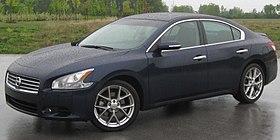 | |
| Overview | |
| Production | May 27, 2008 – 2014[20][21] |
| Assembly | United States: Smyrna, Tennessee |
| Designer | Shiro Nakamura (2006) |
| Body and chassis | |
| Body style | 4-door sedan |
| Layout | Front-engine, front-wheel-drive |
| Platform | Nissan D platform |
| Powertrain | |
| Engine | 3.5 L VQ35DE V6 |
| Transmission | CVT |
| Dimensions | |
| Wheelbase | 109.3 in (2,776 mm) |
| Length | 190.6 in (4,841 mm) |
| Width | 73.2 in (1,859 mm) |
| Height | 57.8 in (1,468 mm) |
| Curb weight | 3,565 lb (1,617 kg) |
The Maxima was redesigned for the 2009 model year and made its debut at the 2008 New York International Auto Show. The seventh generation Maxima (A35) is built on the Nissan D platform sharing this platform with the fourth generation Nissan Altima and second generation Nissan Murano. The exterior and interior design are somewhat similar to the Infiniti G and Infiniti M, with an updated navigation interface and optional USB interface system that works with the main console monitor and steering wheel controls. It serves as Nissan's North American top front wheel drive sedan at Nissan dealerships.
It comes equipped with a revised version of the VQ35DE engine producing 290 hp (216 kW) and 261 lb⋅ft (354 N⋅m) of torque. A revised version of Nissan's Xtronic CVT (continuously variable transmission) with paddle shifting is the only transmission offered, with no manual or regular automatic available.[22] A diesel version was expected to be released for the 2010 model year, although those plans were not realized.[23] The new Maxima is offered in S and SV trims with several premium and technology packages available. The current Maxima's design trades height and length for a sleeker styling, although the width has been increased slightly. The keyless ignition uses a push button to start and stop the engine. In the U.S., the seventh generation Maxima went on sale in late June 2008. The SkyView center glass was replaced by a retractable panoramic moonroof for A35 series Maxima.
Performance:[24]
- 0–60 mph: 5.8 sec.
- Skid Pad Lateral acceleration: 0.85 g
- 1/4 Mile: 14.5 sec. at 99 mph (159 km/h)
- 60–0 mph: 128 feet (39 m)
- 2012
For 2012, Nissan modestly freshened the Maxima's exterior, with a new grille, taillights and new alloy wheels in 18- and 19-inch diameters. Three new exterior colors, Java Metallic, Dark Slate, and Pearl White are available.
The cabin receives a few small trim changes, but is mostly carried over from 2011. A new $710 Limited Edition package on the Maxima 3.5 S bundles smoked xenon headlights, a compass in the rearview mirror, 18-inch dark-silver-finish alloy wheels, rear spoiler, dark satin chrome grille, foglights, outside mirrors with integrated turn signals and metallic trim.
- 2013
The 2013 Nissan Maxima still remains the same for the most part and will be available with three new option packages for the new model year. There is the Bose Audio Package, a Bose audio upgrade with SiriusXM Satellite Radio functionality. The "SV Value Package" includes the premium Bose audio setup along with heated front seats, a heated steering wheel and heated outside mirrors. The Sport Package includes alloy wheels and a climate-controlled driver's seat, combined with the Maxima Monitor Package (a rearview camera system, seven-inch color monitor, USB port and an iPod storage net).
- 2014
Nissan's flagship Maxima sedan entered the 2014 model year in late August 2013 with the addition of a new S Value Package. This has smoked appearance HID Xenon headlights, a compass in the rearview mirror, rear spoiler, fog lights, outside mirrors with integrated turn signals and metallic trim treatment. The Monitor and HID Xenon Packages were no longer available, while the SV received most of the Monitor package as standard. There were two new exterior colors: Gun Metallic (replaces Dark Gray) and Midnight Garnet (replaces Tuscan Sun); for eight available exterior colors total. The 3.5 S and 3.5 SV were the available models, each powered by a 290 hp (216 kW) 3.5-liter V6 engine mated to an Xtronic CVT. 2014 was the last year for this generation Nissan Maxima, despite it carrying over into 2015 as a 2014 model year. Nissan has stated "they will have plenty 2014 Nissan Maximas on dealer lots until the all-new 2016 Nissan Maxima arrives" in calendar year 2015.
Eighth generation (A36; 2015–present)[edit]
| Eighth generation (A36) | |
|---|---|
_–_Frontansicht,_1._Oktober_2016,_New_York.jpg) | |
| Overview | |
| Also called | Nissan 西玛(China) |
| Production | 2015–present |
| Assembly | United States: Smyrna, Tennessee China: Xiangyang (DMCL) |
| Designer | Giovanni Arroba (exterior: 2012)[25] Jackie Chang (interior: 2012)[26] |
| Body and chassis | |
| Body style | 4-door sedan |
| Layout | Front-engine, front-wheel-drive |
| Platform | Nissan D platform |
| Powertrain | |
| Engine | 3.5 L VQ35DE V6 (gasoline) |
| Transmission | CVT |
| Dimensions | |
| Wheelbase | 109.3 in (2,776 mm) |
| Length | 192.8 in (4,897 mm) |
| Width | 73.2 in (1,859 mm) |
| Height | 56.5 in (1,435 mm) |
| Curb weight | 3,471–3,488 lb (1,574–1,582 kg) |
On February 1, 2015, Nissan aired an ad during Super Bowl XLIX titled "With Dad". Near the end of this ad a brief view of the new Maxima was seen.[27] Following the Super Bowl ad, Nissan released two official images of the new Maxima.
The Maxima was unveiled at the April 2015 New York Auto Show. Sporting an athletic body redesign, it features Nissan's "Four-Door Sports Car" positioning, a return to a marketing term used on the third generation J30 series (1988-1992). The vehicle is 82 pounds lighter than before, and it presents the revamped interior taking inspiration from aerospace.[28] The VQ35DE engine was carried over with minor updates and 10 hp (7.5 kW) more power, now rated at 300 hp (224 kW) and 261 lb⋅ft (354 N⋅m) of torque. The Maxima is available with nine exterior color options and five trim levels: S, SV, SL, SR, and Platinum.[29]
This generation Maxima made its debut in China at the 2015 Guangzhou Auto Show with the Chinese name 西玛, which they used as previous generation Nissan Cima.
An updated Maxima will be revealed at the 2018 LA Auto Show with a preview posted by Nissan.[30]
Performance:[31]
- 0–60 mph: 5.9 sec.
- Skid Pad Lateral acceleration: 0.87 g
- 1/4 Mile: 14.4 sec. at 101 mph (163 km/h)
- 70–0 mph: 168 feet (51 m)
Other markets[edit]
In other markets, the Maxima J30 series sold internationally between 1990 and 1994, albeit with different frontal styling to the North American version. Between 1994 and 2003, the "Maxima" name was applied to the Nissan Cefiro sold in Australasia, Europe, and South America. From 2003 until 2013, Nissan in Australasia also retailed the Teana under the Maxima badge.
In the Philippines, the T12 Nissan Auster was sold as the Maxima.
In the United Kingdom, the "Maxima" name was also used in the mid 1980s as a high series trim designation on the B11 Sunny, N12 Cherry and the Japanese built versions of the T12 Bluebird/Stanza.
- J30 (1990–1994)
(sold worldwide) - A32 (1994–1999)
(Australasia, Europe, South America) - A33 (1999–2003)
(Australasia, Europe, South America) - J31 (2003–2009)
(Australasia) - J32 (2009–2013)
(Australasia)
References[edit]
- ^ Jump up to: a b Hogg, Tony (ed.). "Datsun 810 Maxima: A better car in everything but the details". Road & Track's Road Test Annual & Buyer's Guide 1981 (January–February 1981): 59.
- ^ Datsun: Suggested retail prices for 1981 Datsun Models★ (Sales Training/Dealer Support), Gardena, CA: Nissan Motor Corporation in U.S.A., 25 September 1980, p. 4
- ^ Hogg, Tony (ed.). "1981 Buyer's Guide". Road & Track's Road Test Annual & Buyer's Guide 1981 (January–February 1981): 90.
- ^ R&T Buyer's Guide, p. 62
- ^ https://nissannews.com/en-US/nissan/usa/channels/us-united-states-nissan-heritage-nissan-heritage-maxima/photos/1990-maxima-se
- ^ https://books.google.com/books?id=a1wEAAAAMBAJ&pg=PA209&lpg=PA209&dq=october+24,+1988+nissan+maxima&source=bl&ots=wFcUZ100xh&sig=ACfU3U3mvQyUA0sPOLmwugYhsG2ZGVYcQw&hl=en&sa=X&ved=2ahUKEwiF75zCtc7hAhVDd6wKHebaBqYQ6AEwEnoECAgQAQ#v=onepage&q=october%2024%2C%201988%20nissan%20maxima&f=false
- ^ Jump up to: a b c d Kenwright, Joe (1 February 2005). "Nissan Maxima Sedan (1990–95)". Carsales.com. Retrieved 11 May 2015.
- ^ Jump up to: a b "Nissan Maxima (A30 Maxima)". GoAuto. Retrieved 11 May 2015.
- ^ "Nissan Maxima (A30 Series II Maxima)". GoAuto. Retrieved 11 May 2015.
- ^ https://www.motortrend.com/cars/nissan/maxima/1995/1995-nissan-maxima/
- ^ ニューモデル速報 すべてシリーズ 第151弾 新型セフィーロのすべて 電子版 October 16, 1994
- ^ "Nissan Maxima awards and reviews". Nissanusa.com. Retrieved 12 October 2010.
- ^ "Pre-Owned Profile: 1995-1999 Nissan Maxima". AutoTrader.com. Retrieved 2 October 2014.
- ^ "motor trend '95 nissan maxima se from http://www.nissanx.com/old/htdocs/mt1.html – 4 door 3 liter (2998 cc) V6 192.6 PS, 4 speed automatic". nissanx.com. Retrieved 2 April 2011. External link in
|title=(help) - ^ Jump up to: a b Büschi, Hans-Ulrich, ed. (6 March 1997). Automobil Revue 1997 (in German and French). 92. Berne, Switzerland: Hallwag AG. pp. 408–409. ISBN 3-444-10479-0.
- ^ Passell, Peter (23 May 1999). "BEHIND THE WHEEL/2000 Nissan Maxima; Revved Up at a Pared-Down Price". The New York Times. Retrieved 19 June 2015.
- ^ "Nissan adds Maxima production to Smyrna, Tennessee". Retrieved 2 October 2014.
- ^ https://www.nytimes.com/2000/06/30/automobiles/autos-on-friday-design-a-last-chord-from-nissan-s-rocker-designer-spokesman.html
- ^ https://www.adandp.media/articles/nissan's-product-led-transformation
- ^ "Production Begins on Next Generation Nissan Maxima". 27 May 2008. Retrieved 2 October 2014.
- ^ Vijayenthiran, Viknesh. "Nissan Sport Sedan Concept Debuts at Detroit, Previews 2015 Maxima: Live Photos & Video". Motor Authority. Retrieved 2 October 2014.
- ^ "2009 Nissan Maxima".
- ^ "2010 Nissan Maxima to have diesel option".
- ^ "2009 Nissan Maxima Car And Driver Road Test" (PDF). caranddriver.com. Retrieved 1 September 2008.
- ^ U.S. Patent D770,943
- ^ https://www.linkedin.com/in/jackie-chang-3669b14
- ^ Nissan 2015 Super Bowl Commercial - "With Dad". YouTube. 1 February 2015.
- ^ "2015 New York Auto Show: The Complete Roundup". leftlanenews.com.
- ^ "At a Glance: 2016 Nissan Maxima" (Press release). Nissan. 2 April 2015. Retrieved 14 June 2016.
- ^ "2019 Nissan Maxima Update Previewed | Kelley Blue Book". Kbb.com. Retrieved 18 November 2018.
- ^ "2016 Nissan Maxima Car And Driver Road Test". caranddriver.com. Retrieved 4 December 2018.
- "Datsun 810 and Nissan Maxima". Edmunds.com. Retrieved 25 March 2005.
External links[edit]
| Wikimedia Commons has media related to Nissan Maxima. |
| show « previous — Nissan road car timeline, United States and Canadian markets, 1980s–present
|
|---|
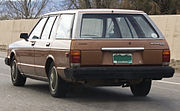





_Ti_sedan_(2015-08-07)_02.jpg)
_Executive_sedan_(13478874153).jpg)

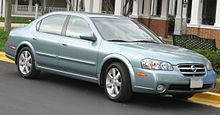
.jpg)
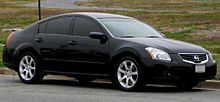

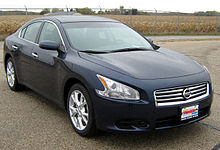
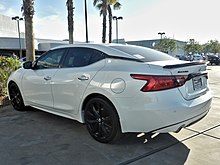
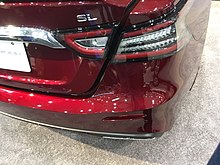
_Ti_sedan_(2015-08-07)_01.jpg)
_30J_sedan_(2011-04-28)_01.jpg)
_ST_sedan_01.jpg)
_ST-L_sedan_(2016-01-04)_01.jpg)
_250_ST-L_sedan_01.jpg)